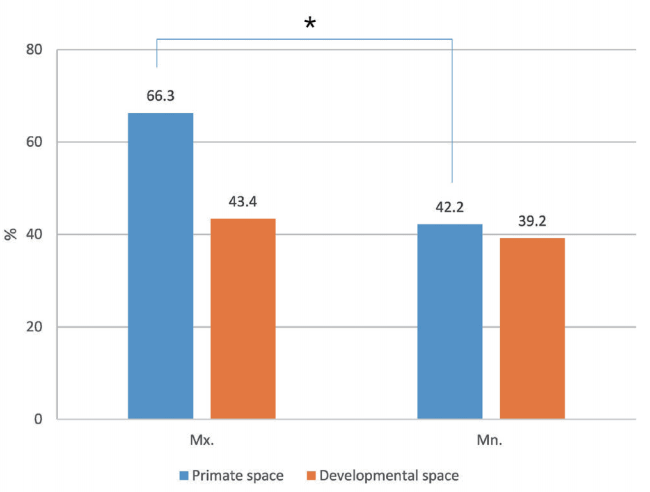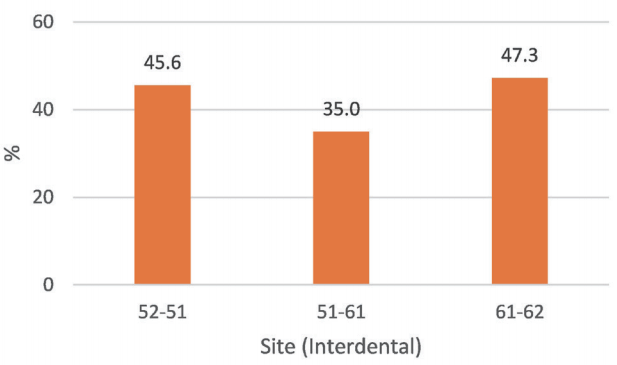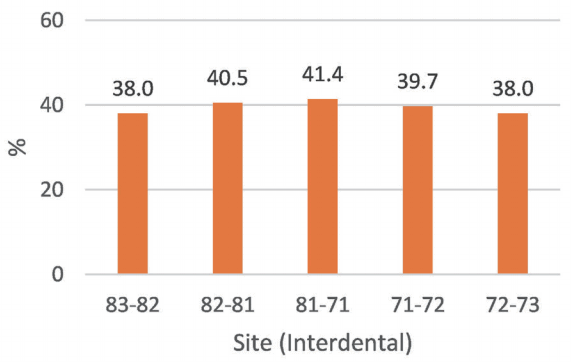화성시 거주 유치열기 어린이의 전치부 치간 공극과 총생에 대한 예비연구
Anterior Spacing and Crowding in the Primary Dentition in Hwaseong City : A Preliminary Study
Article information
Abstract
본 연구의 목적은 화성시에 거주하는 유치열기 어린이의 전치부 공극과 총생에 대해 알아보는 것이다. 한 명의 소아치과 전문의가 만 3 - 4세 유치열기 어린이들의 구강 내 임상 사진을 촬영하였으며, 400명 중 237명이 포함 기준을 충족하였다. 전치부 공극의 유무는 인접면 접촉의 유무로 판단하였다.
상악에서 생리적 치간 공극이 관찰되는 어린이는 47.3%였으며, 하악에서는 38.0%였다. 양악 모두에서 접촉 혹은 총생의 치열을 보이는 어린이는 43.5%였다. 여아보다 남아에서 생리적 치간공극이 존재하는 경우가 더 많았다. 상악에서는 영장류 공간이 발육공간에 비해 더 많이 발견되었으나, 하악에서는 그 차이가 적었다. 상악에서는 유중절치 사이에 공극이 있는 경우보다 유중절치와 유측절치 사이에 공극이 있는 어린이가 더 많았으며, 반면 하악에서는 유중절치 사이에 공극이 있는 어린이가 유중절치와 유측절치 사이 혹은 유측절치와 유견치 사이에 공극이 있는 어린이보다 많았다. 본 연구를 통해 3 - 4세 유치열기 어린이의 전치부 공극과 총생의 정도를 파악할 수 있었으며, 추후 더 많은 표본으로 조사가 필요할 것으로 사료된다. 유치열기의 전치부 공극 혹은 총생은 어린이 개인에 따라, 성별에 따라, 악궁에 따라, 치간 위치에 따라 다른 정도를 보이므로, 치과의사는 유치의 치관부를 수복할 때 이에 대한 인식 하에 치료를 시행하여야 한다.
Trans Abstract
The aim of this study was to assess the spacing and crowding of the anterior teeth in the primary dentition in Hwaseong city. Photographs of the anterior segment of 237 children satisfied the criteria. The presence of primate spaces and developmental spaces was assessed by the proximal contacts.
Physiologic spacing was observed in 47.3% and 38.0% of the cases in the upper and lower arches, respectively. 43.5% showed the presence of two-segment contact or crowded dentition. Physiologic spacing was observed more in boys than in girls. In the maxilla, primate space was more frequent than developmental space; however, in the mandible, the difference was low. In the maxilla, the space between the central incisor and the lateral incisor was more frequent than the space between both central incisors. In contrast, in the mandible, the space between both central incisors was more common than the space between the central and lateral incisors or between the lateral incisors and canine.
The present study describes the tendency for anterior spacing and crowding in the primary dentition. Further longitudinal studies with a larger sample are needed. Dentists should consider these concepts of spacing or contact/crowding when performing full coronal restorations of primary anterior teeth.
Ⅰ. Introduction
Anterior spacing in the primary dentition is a common phenomenon and these spaces are called physiologic interdental spaces[1]. These spaces later play a crucial role in the alignment of permanent teeth[2]. Absence of these spaces in the primary dentition is an expression of disproportionality between the jaw and tooth size[3].
There are similar reports in different countries regarding anterior spacing or crowding of primary teeth[4-7]. In Korea, Im et al.[8] reported that 63.2% male and 57.8% female children aged 3 - 5 years have anterior spacing.
The aim of this study was to investigate the prevalence of anterior spacing or contact/crowding in the primary dentition in Hwaseong city, a satellite town of Seoul. Understanding of the frequency of physiologic interdental spaces is important to pediatric dentists. Moreover, this can be the basis for long-term research on anterior spacing in the primary dentition, in Korea.
Ⅱ. Materials and Methods
1. Subjects
This study was approved by the institutional review board of Yonsei University Dental Hospital (2-2016-0019). A pediatric dentist took intraoral photographs of children who first visited a local clinic, with the chief complaint of oral examination. The dentist was a specialist, who had already finished a residency in pediatric dentistry in Yonsei University Dental Hospital. Intraoral photographs of 400 children were taken in occlusal view, both the maxilla and the mandible. However, according to the following inclusion and exclusion criteria, the study sample comprised 237 children.
The inclusion criteria were as follows:
1) Children aged between 3 and 4 years
2) Children with a complete set of primary dentition
The exclusion criteria were as follows:
1) Children with missing teeth (due to any reason)
2) Children with proximal dental caries
3) Children with dental deformities like fusion, gemination, hypodontia or hypoplasia
4) Children with displacement of teeth due to trauma
5) Children who had received any form of orthodontic treatment
2. Analysis method
The presence or absence of physiologic spaces in the anterior teeth was determined based on the existence of the proximal contact. If the proximal contact was invisible, the site was classified “spacing”. If the proximal contact was visible or the teeth overlapped, the site was classified “no spacing”. If the upper arch had “spacing” more than three sites, the arch was considered “spacing dentition”, because the upper arch has five sites of physiologic space. If the upper arch had “spacing” at less than two sites, that arch was considered “contact/crowding dentition”. In contrast, if the lower arch had spacing at more than four sites, that arch was considered “spacing dentition”, because the lower arch has seven sites of physiologic space. If the lower arch had “spacing” less than three sites, that arch was considered “contact/crowding dentition”.
3. Statistical analysis
To ensure intra-examiner reliability, the same examiner examined 100 children on two occasions, at least two weeks apart. Repeatability was evaluated with intra-class correlation coefficients (ICC). The test-retest reliability coefficient was 0.98 (95% confidence interval 0.97 - 0.99) and showed good reliability. SPSS 22.0 (SPSS Inc.; Chicago, IL, U.S.A.) for Windows was used for statistical analysis. Comparisons between the groups were carried out using Pearson’s Chi-square test. For all tests, a p-value of 0.05 or less was considered statistically significant.
Ⅲ. Results
The study sample consisted of 125 boys and 112 girls, with an average age of 3.5 years.
The frequency of spacing and contact/crowding in the anterior segments is shown in Table 1. Physiologic spacing was observed in 47.3% and 38.0% cases in the upper and lower arches, respectively. Contact or crowded dentition was found in 52.7% and 62.0% cases in the upper and lower arches, respectively. Overall, 28.7% of the cases showed the presence of two-segment spacing dentition, and 43.5% showed the presence of two-segment contact or crowded dentition.
The differences in the frequency of spacing or contact/crowding between boys and girls are also shown in Table 1. Boys had more physiologic spacing than did girls. However, girls had a higher rate of contact or crowding dentition than did boys.
Figure 1 shows the frequency of primate space and developmental space in the maxilla and mandible, respectively. Primate spaces were more frequent in the maxilla than in the mandible (p < 0.05). However, regarding the developmental spaces, the differences between the maxilla and mandible were low.

Frequency of primate spaces and developmental spaces in the maxilla and mandible. A statistically significant difference was observed in the maxilla.
Pearson’s Chi-square test (* : p < 0.05).
The frequency of developmental spaces is shown in Fig. 2 and 3. In the maxilla, spacing between the central and the lateral incisors was more common than between both the central incisors. In contrast, in the mandible, spacing between both the central incisors was more common than that between the central and lateral incisors or between the lateral incisor and canine.
Ⅳ. Discussion
The primary dentition is completely established at the age of 3 years, and transitions toward permanent dentition with the eruption of the first permanent tooth. From 3 to 4 years of age, the dental arches are relatively stable and changes minimally. However, at 5 to 6 years of age, the size of the dental arch begins to change due to the eruption force of the first permanent molar[9]. Therefore, this study only included 3 - 4 years old children.
In the present study, 47.3% of the cases showed physiologic spaces in the maxillary arch, which is higher than in the reports of Indian[6] and Nigerian children[4]. However in the mandibular arch, 38.0% of the cases showed physiologic spaces, which is similar to that of the Indian children[6] but lower than that of the Nigerian children[4].
In our study, primate spaces were present in 66.3% of the cases in the upper arch and 42.2% of the cases in the lower arch. In Jordanian children, the corresponding figures for the primate space in the upper and lower arches were 68.0% and 55.7% respectively[5].
Contact between the teeth or crowding in the anterior segment of the maxilla and the mandible were reported to be present in 52.7% and 62.0% of the cases, respectively. The prevalence rate was lower in the report of Nigerian children by Otuyemi et al.[4], and that of Indian children by Hegde[6].
As for the interdental spaces in the primary dentition, there are differences depending on the country, race, and sex. There is no clear explanation for the cause of this diversity, although it is estimated that eating habits and genes may have an effect. Long-term follow-up studies are needed on more samples to determine the cause of country-specific and regional differences.
It has been considered normal for physiologic interdental space in the primary dentition. However, in our sample, spaced dentition group were fewer than contact/crowding dentition group in the anterior primary teeth. 28.7% of the children had spacing in both the arches, while 43.5% of the children had contact/crowding in both the arches. These results are in agreement with those of previous studies[10,11].
Primate spaces were observed more frequently in the maxilla than in the mandible (Fig. 2). Children who had primate spaces in the maxilla were greater in number than children who had developmental spaces. However, the number of children who had primate spaces in the mandible were analogous to that of the children who had developmental spaces. Fig. 2 and 3 show the presence of spacing and sites of developmental spaces. Dentists should consider these concepts of spacing or contact/crowding when performing full coronal restorations of primary anterior teeth (due to any reasons, including trauma or advanced dental caries).
In the case of contact or crowding dentition in the primary dentition, there is a high possibility of food impaction and plaque accumulation[12]. Several reports concluded that crowding of primary teeth and incidence of proximal dental caries are correlated[13]; however, it is controversial that for the anterior teeth, this relation is weak[14]. Furthermore, some reports concluded that crowding in the primary dentition can lead to crowding in the permanent dentition, while others indicated that this cannot be ascertained[15]. Pediatric dentists should pay attention to anterior spacing or crowding in primary teeth, despite of this controversial opinion.
In this study, analysis of intraoral photographs was performed instead of cast analysis. This study has a limitation in that the existence of spacing was determined only on the basis of contact points. If we had used cast analysis, it would have been possible to check for the existence of spacing by flossing the interproximal area or measuring arch length discrepancy. However, many related studies[4-6] in the past have determined the presence or absence of spacing using only an oral examination; thus, the results of our study are likely to be meaningful.
In addition, we reviewed several previous papers to decide upon a definition for spaced dentition. Many other similar studies had not used a uniform definition of generalized spaced dentition or crowded dentition. It is not clear whether the presence of spacing in only one-half of the arch can be considered spaced dentition. Hence, it is important to come up with a conclusive definition for spaced dentition so that the results can be compared locally in Korea.
The present study described a tendency for the spacing and crowding in the primary dentition. Further longitudinal studies with larger samples are needed to follow up the cases through the growth period to ascertain the changes that may occur during the transition from primary to permanent dentition.


